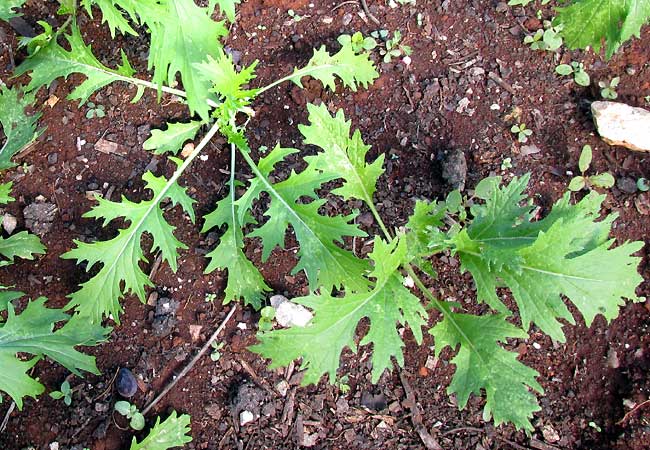Excerpts from Jim Conrad's
Naturalist Newsletter
from the November 27 2016 Newsletter issued from Rancho Regenesis in the woods ±4kms west of Ek Balam Ruins; elevation ~40m (~130 ft), N20.876°, W88.170°; north-central Yucatán, MÉXICO
MIZUNA IN THE GARDEN
Last February when volunteer identifier Bea in Canada visited me at Chichén Itzá she brought along several packages of garden seeds. Among the packages was one whose seeds produced the plants shown below:growing in my garden here at the rancho:

According to the seed package's label, those are young Mizuna Mustard Spinach plants. Mizuna's Wikipedia page tells us that Mizuna is BRASSICA RAPA subspecies NIPPOSINICA. Brassica rapa is the Turnip, so we can think of Mizuna as a kind of turnip plant with edible leaves but no turnip.
The leaves do have a turnipy taste, but it's much subtler. Fact is, they don't have much of a taste at all and probably do best in one of those salads where the main feature is a fancy salad dressing.
The seed package describes what's in our picture as an early maturing Japanese mustard that can be eaten raw in salad, or cooked. At least sixteen Mizuna cultivars have been developed, with such names as "Kyona Mizuna", "Komatsuna Mizuna", "Kyoto Mizuna", "Happy Rich Mizuna", "Summer Fest Mizuna", and "Tokyo Early Mizuna."
It's always fun to grow new things, and I like seeing its green, nutritious leaves in my morning stews these chilly mornings when I sit beside the campfire watching the sun rise -- even though I can't see that they contribute much taste.